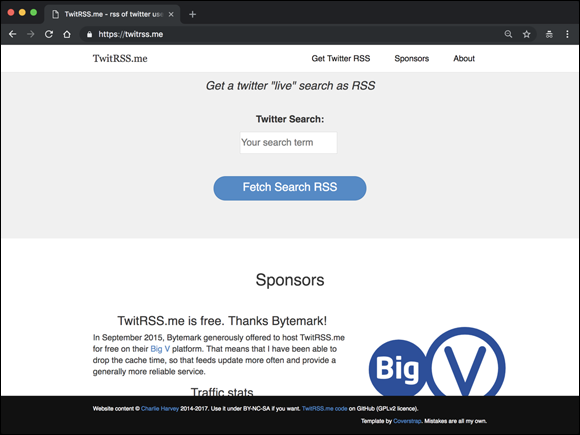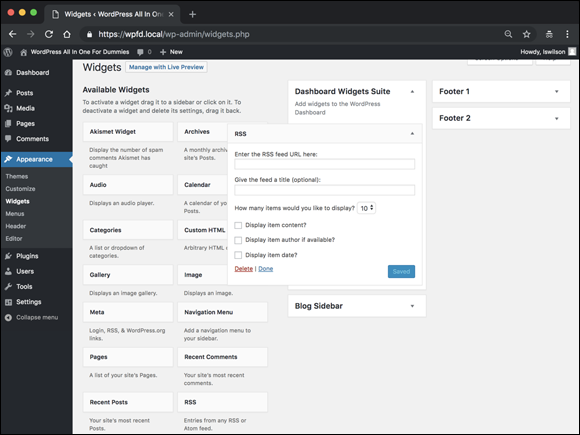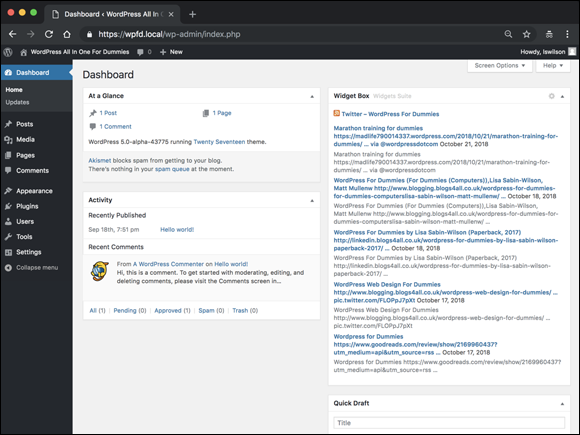Chapter 2
Creating a Social Media Listening Hub
IN THIS CHAPTER
 Understanding why you need to monitor your brand
Understanding why you need to monitor your brand
 Finding out which monitoring tools are right for you
Finding out which monitoring tools are right for you
 Cleaning and aggregating your monitoring data
Cleaning and aggregating your monitoring data
 Turning your WordPress Dashboard into a listening post
Turning your WordPress Dashboard into a listening post
This chapter focuses on the importance of listening to social media, using the free monitoring services available to you, and integrating these sources into your WordPress installation so that you can turn your run-of-the-mill WordPress installation into a social media listening hub.
A social media listening hub is a collection of information from several sources, including mentions of your site, keywords, or topics that you write about, and even information about competitors. You can sign up for services that monitor these topics, such as Salesforce Marketing Cloud (https://www.salesforce.com/products/marketing-cloud/overview) and Gigya (https://www.gigya.com). But most of these services cost money and give you another place to log in to, and you may not use these kinds of services to their full capacity. For a small business or an independent site owner, the investment (both time and financial) doesn’t always make sense. By leveraging the power of the WordPress platform, you can easily cut down on both the time and financial commitment of monitoring platforms.
In this chapter, I walk you through determining what sources you should pull your data from, determining and searching for the keywords you deem important, and integrating your search results into your WordPress Dashboard. Additionally, I look at some other tools that can help you expand your monitoring practices.
Exploring Reasons for a Social Media Listening Hub
When you begin to engage in the world of social media, one of the most important things you can do is monitor what Internet users are saying about your company, your site, you, or your products. By investigating what Internet users are saying, you can find and participate in discussions about your site or company and come to an understanding about the way your community views your site (or brand). With this information, you can participate by responding to comments on other sites, like Twitter, or Facebook Groups or by creating targeted content on your own site.
The conversations happening about your area of interest or niche amount to really great intelligence. For a business, regardless of whether you participate in social media, social media users are talking about your company, so you need to be aware of what they’re saying. If you’re blogging about a particular topic, you can evolve your content by tracking what members of your niche are saying about it.
Eavesdropping on yourself
By monitoring your niche, you can eavesdrop on thousands of conversations daily and then choose the ones in which you want to participate. The social media listening hub you create allows you to follow various conversations going on through microblogging services such as Twitter, Facebook, blogs, news sites, Reddit, and even comments on YouTube. If someone says something negative about you, you can respond quickly to fix the situation. You can attempt to step in and make sure that people are informed about what you’re doing.
Keeping tabs on your brand
Think about what keywords or phrases you want to monitor. You want to monitor your name and your blog/company name, of course, as well as other keywords that are directly associated with you.
If Green Bay Packers quarterback Aaron Rodgers wanted to set up a monitoring service, for example, he might use the keywords Aaron Rodgers, Arron Rodgers, Aaron Rogers, Green Bay Packers Quarterback, and perhaps even the phrase associated with his touchdown celebration: discount double check. If he wanted to expand this service past direct mentions of him or his team, he could also include more general terms such as NFL Football or even NFC Teams. The general term NFL Football may be too general, though, producing too many results to monitor.
Additionally, you may want to view your site or company through the lens of your customers. What terms do they associate with your company? Looking at your site from other points of view can provide good ideas for keywords, but not always. Although you don’t always want your company to be known for these terms and may not see yourself that way, getting the perspective of other people can open your eyes to how users view your website.
Don’t think of this process as just pulling in keywords, either. You can pull in multiple feeds, just as you do with an RSS reader, which allows you to monitor specific sites. So if you concentrate on an industry, and a website deals specifically with your industry and has an active news flow pushed through an RSS feed, you may want to consider adding specific websites to the mix of feeds you run through WordPress.
The setup in WordPress that I describe in this chapter gives you the convenience of having everything in one place and can help you monitor your brand, company, or website. If you own a restaurant, hotel, or bar and want to pick up review sites such as Yelp and TripAdvisor, these tools can’t do the job. Most social media monitoring tools don’t count review sites as social media. Tools such as Reputation Ranger (http://reputationranger.com) can monitor ratings sites for a nominal monthly fee if you want to pay attention to those types of sites.
Exploring Different Listening Tools
You can find tons of monitoring and listening tools that oversee the social media space. If you work for a large company, you can use large, paid tools such as Salesforce Marketing Cloud (https://www.salesforce.com/products/marketing-cloud/overview), Gigya (https://www.gigya.com), Alterian (https://www.alterian.com), and Lithium (https://www.lithium.com). Pricing for these tools runs from a few hundred dollars to tens of thousands per month. Most individuals and small businesses can’t make that investment. If you’re one of the smaller guys, you can create your own monitoring service right in WordPress by importing free monitoring tools into your Dashboard to create a social media listening hub.
Some monitoring tools pick up site coverage, Twitter remarks, and message-board comments. Other tools pick up content created with video and pictures. Try the monitoring services mentioned in the following sections, and determine which give you the best results and which make you feel the most comfortable. Then choose the best tools to create a good monitoring mix. One solution probably can’t cover everything, so experiment with different combinations of tools.
Although some of the monitoring tools in the following sections don’t apply to every type of website, I’d include them in most monitoring setups.
For each search that you do on a monitoring service, you need to log the feed address. To make recording these addresses easy, open a spreadsheet or a document into which you can paste the various feeds. You can collect them in one place before you begin to splice them together (which you do in “Creating Your Own Personal Monitoring Mix” later in this chapter). Think of this document as a holding area.
Monitoring with Google Alerts
Most social media experts consider Google Alerts (https://www.google.com/alerts) to be a must-use monitoring source for anyone dabbling in social media. Google Alerts allows you to set up monitoring on news sites, blogs, pictures, videos, and groups. You can toggle the amount of results you see, from 20 to 50, and you can choose how often they come in (in real time, daily, or weekly). You can also have Google deliver your alerts to your email or via RSS.
Google Alerts isn’t perfect, but it doesn’t have many drawbacks. Some of the specialized searches (such as Boardreader, which targets message boards; see “Searching communities with Boardreader” later in this chapter) pick up more in their areas of expertise than Google Alerts does, but in general and compared with other tools, Google Alerts covers the widest range of content.
You can easily set up Google Alerts by following these steps:
Navigate to
https://www.google.com/alertsin your web browser.The Alerts page loads, welcoming you to the Google Alerts website.
In the search text box, type the keyword or phrase that you want to monitor.
If you enter a phrase in which the words have to go in that particular order, put the phrase in quotation marks.
From the Show Options drop-down menu, choose the type of monitoring that you want to use.
The options send you different kinds of alerts:
- How Often: Determine how often you’ll receive these notices. Because you’ll receive the updates via RSS and not email (which you set up in step 4), you want the highest frequency possible, so choose the As-It-Happens option. Other options include a daily, weekly, and monthly digest.
- Sources: Select the type of sources you want Google Alerts to search in (news, blogs, video, and so on).
- Language: Select the language you want Google Alerts to search.
- Region: Select the region you want Google Alerts to search.
- How Many: Select how many results you want to receive. If you choose As-It-Happens for How Often, for example, you receive items in real time, so you don’t need to specify the number of items; choose Only the Best Results or All Results.
Choose your delivery type from the Deliver To drop-down menu.
To make the delivery source an RSS feed, as opposed to an email, choose RSS Feed.
Click the Create Alert button.
You see your Google Alert Management screen, where you can get the RSS feeds for all your Google Alerts.
- To get the URL of the RSS feed, right-click the RSS Feed icon shown to the right of the alrt you created, and choose Copy Link Address from the shortcut menu that appears.
- Paste the copied link location into a document in which you list all the feeds that you plan to aggregate later.
- Repeat steps 2 through 7 for all the alerts you want to monitor.
Tracking conversations on Twitter with RSS
Tracking mentions on Twitter via RSS is relatively simple. You just need to know what you’re looking for and how to build the RSS links so you can monitor them. You can look for several items to monitor your brand and reputation via the Twitter social network, including the following:
- Username: Monitor when your Twitter name is mentioned and by whom.
- Hashtags: Monitor specific Twitter hashtags (such as #wordpress).
- Keywords: Monitor Twitter for a specific word.
The Twitter service itself doesn’t make RSS feeds available for public consumption on the web, but a service called TwitRSS will turn your Twitter searches into RSS feeds. You can find this service by visiting https://twitrss.me. TwittRSS, which currently is free, allows you to create RSS feeds for a specifc user or search term on Twitter. When you’re on the site, type a specific search term in the Twitter Search text box. (See Figure 2-1.)

FIGURE 2-1: TwitRSS search service.
Following are examples of Twitter RSS links that I created:
- Twitter RSS URL for my Twitter username:
https://twitrss.me/twitter_search_to_rss/?term=Lisa+Sabin-Wilson - Twitter RSS URL for the keywords WordPress For Dummies:
https://twitrss.me/twitter_search_to_rss/?term=WordPress+For+Dummies - Twitter RSS URL for the hashtag #WordPress:
https://twitrss.me/twitter_search_to_rss/?term=%23WordPress
Build the Twitter RSS URLs that you want to monitor by copying the link provided by TwitRSS (displayed in your browser’s address bar) and including it in the document where you’re listing all the RSS feeds you want to aggregate later.
Searching communities with Boardreader
Boardreader (http://boardreader.com) is a must-add tool because it focuses on groups and message boards, where conversations have been happening much longer than on Facebook and Twitter. Many other monitoring tools overlook these areas when talking about monitoring the web, but you can find many vibrant communities that are worth being part of, in addition to monitoring what’s being said about your blog or company.
To set up your Boardreader tracking, follow these steps:
- Navigate to
http://boardreader.com. - In the text box, type the search term that you want to monitor; then click the Search button.
- Copy the URL from your browser’s address bar.
- Paste this URL into a document in which you list all the feeds that you plan to aggregate later.
- Repeat steps 2 through 4 to search for and monitor as many search terms as you want.
Creating Your Own Personal Monitoring Mix
After trying out the various monitoring services, you can create a mix of services to import into your WordPress Dashboard. You import the results of these monitoring services with the help of RSS (Really Simple Syndication). You can combine different single RSS feeds into one RSS feed and create an organized setup for all the information you have to manage. If you have various RSS feeds from different sources for the keyword cookies, for example, you can combine them into one RSS feed. Or if you want to combine various feeds based on sources such as all your Twitter RSS feeds, you can do that as well.
After you copy the locations for all your RSS feeds in one document, you need to group those RSS feeds. Grouping your RSS feeds keeps your monitoring system nice and tidy, and allows you to set up the WordPress Dashboard easily. After you group these feeds, you splice them together to make one master feed per grouping (see the following section). If you’re tracking a variety of keywords, you may want to put your feeds into groups. Wendy’s Restaurants, for example, could make these keyword groupings:
- Grouping 1: Your brand, products, and other information about your company
- Wendy’s (the company name)
- Frosty (a prominent product name)
- Wendy Thomas (a prominent person in the company)
- Grouping 2: Competitors
- McDonald’s
- Burger King
- In-N-Out
- Grouping 3: Keyword-based searches (Burgers)
- Hamburgers
- Cheeseburgers
- Grouping 4: Keyword-based searches (Fast Food)
- Fast food
- Drive-through
- Grouping 5: Keyword-based searches (Chicken)
- Chicken sandwiches
- Chicken salad
- Chicken nuggets
In each of these groups, you place your Google Alerts feed, Twingly feed, and whatever other feeds you feel will provide information about that subject area. You can blend each group of feeds into one master feed for that group and bring them into WordPress.
Grouping all your various feeds gives you the most complete monitoring solution by covering multiple monitoring tools and blending them. You get more coverage of your brand or blog than you would by using Google Alerts alone. On the down side, you may see some duplicates because of overlaps between the services.
If you feel overwhelmed by duplicate search results, you can blend one feed that covers only your brand, or you can simplify setting up your monitoring even more by keeping one feed for each item, as follows:
- General overview: Google Alerts or social mention
- Message boards: Boardreader
- Microblogging: Twitter search
Editing the Dashboard to Create a Listening Post
After you choose your data sources, clean up your feeds, and put them all in individual RSS feeds, you can finally bring them into WordPress and set up your social media listening hub.
You can bring these RSS feeds into your Dashboard through a plugin called Dashboard Widgets Suite, which you can find in the WordPress Plugins page at https://wordpress.org/plugins/dashboard-widgets-suite.
Follow these steps to set up the Dashboard Widgets Suite plugin and configure it to create a social-listening Dashboard in WordPress:
From the Plugins menu on the left side of your WordPress installation, choose Add New.
This step takes you to the form where you can search for new plugins.
In the Search text box, type Dashboard Widgets Suite; then click the Search Plugins button.
The search results page appears.
- Search for the Dashboard Widgets Suite plugin, and click the Install Now link, which installs the plugin on your site.
- When the installation is complete, activate the plugin by clicking the Activate button on the Add Plugins screen that appears to the right of the Dashboard Widgets Suite plugin name.
Choose Dashboard Widgets from the Dashboard Settings menu.
The Dashboard Widgets screen appears.
- Ensure that the Enable the Control Panel Widget check box is selected (as it should be by default).
- Leave all the rest of the default settings in place, and click the Save Changes button.
Click the Widgets link on the Appearance menu.
The Widget Settings page appears.
Add the RSS widget to the Dashboard Widgets Suite widget area.
Drag the RSS widget into the Dashboard Widgets Suite widget.
- Configure the RSS widget to display information from your selected RSS feed (see Figure 2-2):
- Enter the RSS feed’s URL.
- Optionally, give the RSS feed a title by typing a title in the text field.
Repeat steps 8 through 10 for the other widgets on your Dashboard by using your other selected feeds.
After you have your feeds set up, you can configure the appearance of your WordPress Dashboard.
- Drag and drop the new widget boxes where you want them on your Dashboard.

FIGURE 2-2: Configuring the Feed Box widget.
Figure 2-3 displays my Dashboard with the RSS feed from the search I found on TwitRSS for the term WordPress For Dummies, shown in the top-right corner. Now, whenever I log in to my WordPress site, I can see what’s being said on Twitter about my book in real time.

FIGURE 2-3: WordPress For Dummies search term displayed in the WordPress Dashboard.
 Monitor common misspellings and permutations of the name of your brand. The Bing Ads Intelligence tool (
Monitor common misspellings and permutations of the name of your brand. The Bing Ads Intelligence tool ( When your content changes, change what you’re monitoring to match the evolution of what you’re writing about.
When your content changes, change what you’re monitoring to match the evolution of what you’re writing about.